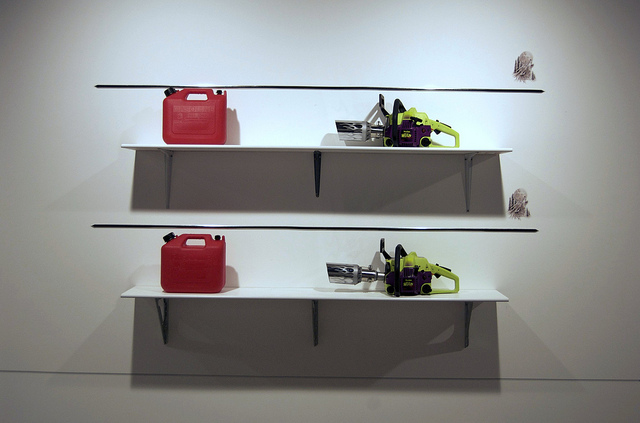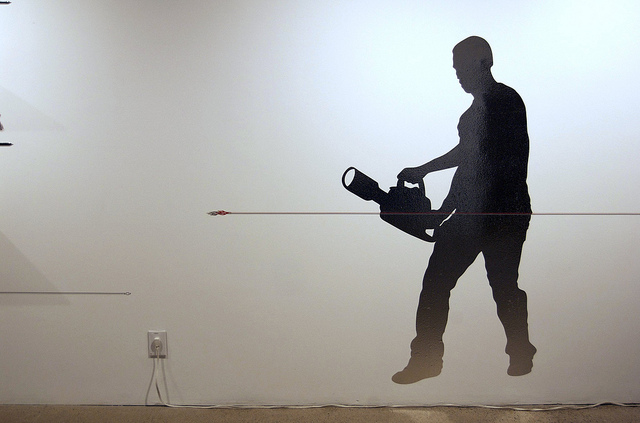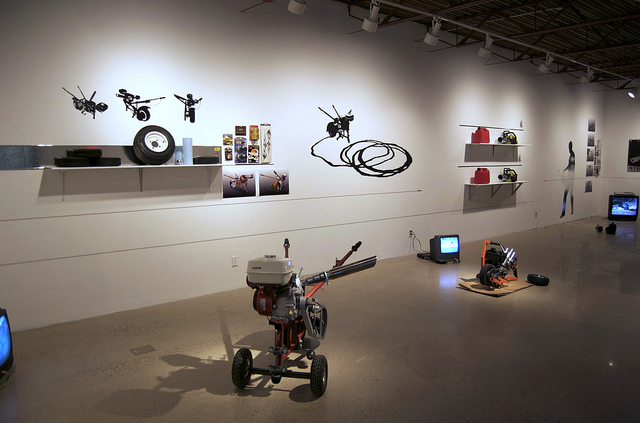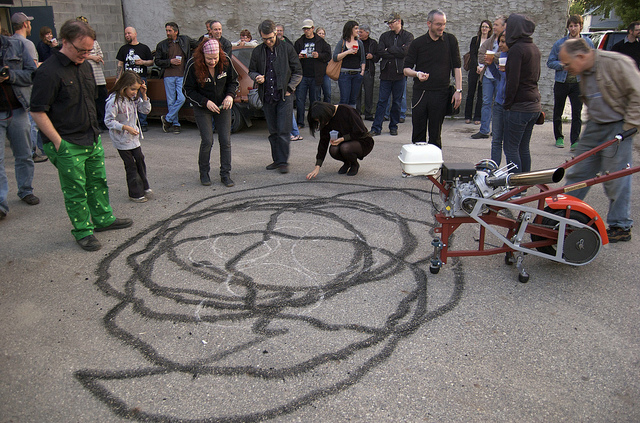The Fast And The Curious
In the middle of the last century, there developed in pockets around North America a complex subculture around customizing vehicles for increased performance and wildly enhanced aesthetics. Fueled by a heady and potentially reckless combination of post-war optimism and disposable income, these young hot-rodders staked their claims to being the fastest and the coolest. Raw elements of the surrounding material culture were transformed into tricked-out, flamed-out, snarling, smoking monsters that would have made Dr. Frankenstein proud. What began with a few mechanically inclined innovators toiling away in their garages in obscurity has become a ubiquitous part of the vernacular. When Kenny Howard (nick-named Von Dutch) started pin striping in the 50s, could he have imagined his eponymous, and posthumous product line touting his signature logo on everything from hats to shoes to cologne in stores worldwide? [1] <#_ftn1>
The exhibition Gearheads brings together the high-octane art of Steven Laurie and Ray Lodoen under the roof of AKA Gallery. While both artists incorporate elements of hot rod culture into their practice, they do so with divergent purposes and to vastly different effect. Laurie designs, fabricates and performs with machines that reference functioning machine tools with a specific purpose and application, re-tooled and adapted to a new use. Lodoen likewise takes pre-existing forms, in his case old motorcycles, which he re-designs and rebuilds into hybridized choppers. The encounter between their practices in the context of Gearheads raises compelling questions around utility, function and form, consumerism and social value systems. It also makes for a white-knuckle ride that’s a whole lot of good, greasy fun.
 Laurie’s installation has the look and feel of a trade show or store and included working prototypes of three different machines. The Donut Machine looks like a mutant rototiller with the tines used for turning the soil replaced by a rubber tire. The front of the machine has a post with a rubberized tip that acts as a pivot point for the tire-burning performances. Close by, another smaller machine called the Handheld Rubber Burner seems to be designed around the basic structure of a handheld masonry saw, with a tire in place of a blade. The names for both of these machines are direct summations of their sole function. Their flat red oxide primer finish and straightforward mechanical design create a stripped-down, home-made aesthetic that is more about getting the job done than flare.
Laurie’s installation has the look and feel of a trade show or store and included working prototypes of three different machines. The Donut Machine looks like a mutant rototiller with the tines used for turning the soil replaced by a rubber tire. The front of the machine has a post with a rubberized tip that acts as a pivot point for the tire-burning performances. Close by, another smaller machine called the Handheld Rubber Burner seems to be designed around the basic structure of a handheld masonry saw, with a tire in place of a blade. The names for both of these machines are direct summations of their sole function. Their flat red oxide primer finish and straightforward mechanical design create a stripped-down, home-made aesthetic that is more about getting the job done than flare.
Video documentation of past performances, including those held in AKA’s parking lot at the beginning of the exhibition, are shown on monitors throughout the space. Laurie uses the Donut Machine and Handheld Rubber Burner as mark-making tools. As he ‘draws’ in front of an inevitably cheering crowd, thick plumes of cloying smoke hang in the air. Once the smoke clears, what remains are swirling patterns of ragged burnt rubber that become etched into the asphalt and remain visible for months to come.
These moments are inspired by the ritualized tire-burning performances that unfold on parking lots and empty streets wherever there are drivers with the means to do so. This ‘making one’s mark in the world’ is motivated by the same drive as the endless examples of “(insert name/initials here) was here” graffiti found on walls since the advent of written language. The impetus behind these gestures extends beyond a simple declaration of existence, however. Such wordless actions communicate a whole range of intentions, regardless of how sublimated their implications may be in the psyche of the actor. Their primary message is good-old chest-thumping bravado; conspicuous displays of a will to power measured in foot-pounds of torque.
Also included are two Wild Thing Handheld Revvers that began as inexpensive and modestly scaled Wild Thing chainsaws by manufacturer Poulan. With a body made of garishly coloured plastic, they already appear to be more toy than tool. They’re the sort of thing any weekend warrior handy-person could be seduced into buying by their fun look. Playing off of this curious aesthetic-to-function ratio, Laurie has replaced the bar and chain with a wide exhaust tip, effectively disabling the machine’s purpose as a tool and rendering it as pure ostentation – just blowing smoke. His casual demeanor revving the engine as he sits on a fallen tree in the woods in the documented performance speaks to a culture where home improvement has become more leisure activity than a drudging necessity.
 Interspersed throughout the space are several silhouettes of the machines and their marks rendered in flat black vinyl cut outs. Their effect is a literal and figurative flattening of the temporal experience of the work into a loaded signifier. Also included is a life size chrome vinyl silhouette of Laurie holding one of the Wild Things at his hip in a pose that is as much rockstar as it is lumberjack. Laurie’s tongue-in cheek and patently suggestive posturing here is genuinely funny. Our inevitable laughter points to a risky strategy. While we could read the work from this vantage point as a bit of a lark, it clearly calls for a far more subtle critique on our part, leading us to question normative cultural values of masculinity.
Interspersed throughout the space are several silhouettes of the machines and their marks rendered in flat black vinyl cut outs. Their effect is a literal and figurative flattening of the temporal experience of the work into a loaded signifier. Also included is a life size chrome vinyl silhouette of Laurie holding one of the Wild Things at his hip in a pose that is as much rockstar as it is lumberjack. Laurie’s tongue-in cheek and patently suggestive posturing here is genuinely funny. Our inevitable laughter points to a risky strategy. While we could read the work from this vantage point as a bit of a lark, it clearly calls for a far more subtle critique on our part, leading us to question normative cultural values of masculinity.
Adding to the ambiance of a trade show, Laurie has adorned the walls with pre-packaged after-market novelties for the budget conscious hot-rodder. Howling wolf images, metallic flames and complex pin striping motifs are rendered as peel and stick decals. Fake plastic exhaust pipe tips that can be adhered to a car’s rear corner panel create the illusion of having souped-up the exhaust system to enhance performance. These trinkets are produced with the intention of embodying notions of power and rugged individualism, condensed and commodified into generic after-market baubles. The irony Laurie raises here is that adding these ‘personalized custom touches’ to a vehicle is little more than an arbitrary selection of pre-packaged products. These manufactured knock-offs replicate the surface effects of a sub-cultural narrative predicated on the same instinct of display that plays out in the sexual selection rituals of innumerable species. After all, what separates the drive to ‘trick-out’ a vehicle with all of these cheap signifiers of style from a peacock fanning out his iridescent plumage?
A pair of large matching mudflaps feature stainless steel cut-outs of the Wild Thing and the artist’s first and last name. The works are part of a larger project wherein Laurie had truckers install the mudflaps of his own design on their trucks to be seen by anyone who crossed paths with the. Branding his own name and disseminating the work in this way is more than a shameless plug; it insinuates his artistic practice into an arena where art dialogue is generally absent, engaging a public that is normally worlds away from the concerns of art.
 Laurie’s practice is too grounded in an honest sense of exuberant engagement with his material and subject to be cynical. His work is critical, not in the sense of attacking or negating the cultural norms he navigates but rather in asking questions of his audience, how they sit in relation to those broader social constructions, and why.
Laurie’s practice is too grounded in an honest sense of exuberant engagement with his material and subject to be cynical. His work is critical, not in the sense of attacking or negating the cultural norms he navigates but rather in asking questions of his audience, how they sit in relation to those broader social constructions, and why.
Over the past several years, Ray Lodoen’s studio practice and garage work have coalesced into a singularly focused methodology. While incorporating some prefabricated parts, particularly the engine and electrical components, the overall design of his chopper motorcycles are the product of imagination. The frame and tank are custom built and meticulously welded, painted and pinstriped into personalized expressions of Lodoen’s own formal sensibilities. Necessity being the mother of invention, one of the more charming features on one of the bikes is a clear plastic jewel-cut doorknob serving as the suicide-shifter knob. The aesthetic appeal of such carefully crafted and inventive work is compelling on a variety of levels, not the least of which is that unquantifiable and thoroughly elusive designation of ‘cool,’ the response these bikes seemed to elicit from gallery goers most often.
This is no simulacrum. Lodoen’s bikes sidestep processes of re-presentation and simply exist as they are, in toto. As such, there are specific parameters defining the material potential for the work. First, the bikes need to be safe to ride. What Lodoen stakes here is quite literally his own life and limb. Having a weld fail on the highway is far more serious than receiving a bit of negative criticism from one’s peers. Second, the bikes need to be street legal. While custom modifications tend to flirt with the boundaries of legal specifications, getting pulled over and sidelined for being a half-inch over or under could potentially undo many months in the garage. Third, Lodoen’s chosen hot-rod idiom carries with it a certain set of prescriptive aesthetic values that have been progressively codified as the scene has matured and entered the mainstream. As part of popular culture, the ‘look’ serves as a point of identification for the mechanically inclined and inept alike.
It would be difficult to consider Lodoen’s bikes here without at least touching on the old, yet seemingly indefatigable question of where the distinction lies between capital ‘A’ Art and craft. The more I thought this question over, the more problematic and arbitrary it became. If we agree to call the work of a welder and mechanic ‘craft’ because it has a discreet and discernible function, does it follow that in order for an object to be ‘art’ it needs to have no discernible function? Because I kept returning to permutations of this question again and again with no obvious resolution at hand, I felt I was closing in on something. Motorcycles as motorcycles still operational as transportation, however flashy, make for an interesting study in contrast with Laurie’s work where the original practical function has been disabled or otherwise subsumed to the intentions of the artist.
Even with all of their distinctive touches, presenting Lodoen’s fully functioning choppers in the context of an art gallery could be read as an essentially Duchampian gesture. Perhaps this does play with the notion that the artist’s selection of the object in question constitutes the conceptual leap from ‘object’ to ‘art object’ and validates its designation as such. The questions raised here became even more convoluted when, due to some last minute glitches in the garage with the bikes’ fuel and electrical systems, neither of them was actually running in time for the exhibition opening. With their utility on hold, did the bikes become sculptural objects or were they still motorcycles?
Lodoen’s installation neatly addresses these various lines of inquiry and personalizes his practice with the inclusion of two elements: a checker-plate and red thermoplastic light box formed in his own initials logo and a vinyl lettering band spanning his half of the gallery, repeating RayLo Designs. RayLo is the cheeky brand name Lodoen applies to his creations, with the intentional reference to “J.Lo” (pseudonym for American entertainer Jennifer Lopez). Here, Lodoen addresses the process whereby a human being is transformed into a celebrity, and from there into a cleverly designed and packaged brand. Condensing all of the messy variables of a living individual into an abstract, essentialized glyph necessarily leaves out all manner of telling details. What we’re left with is an empty sign, easily traded as capital. Lodoen’s self-branding makes the point that this reductive movement operates in the art world as often and with as much conviction as the entertainment or business world. Much like Laurie’s mudflap project, Lodoen’s signature thus becomes a work of art itself.
Gearheads brought many enthusiastic visitors into AKA who may not otherwise have ventured to darken the doors of an art gallery. Beyond whatever critical considerations we may bring to bear on the work of these artists, there is always our initial gut response. This is not the usual chin-stroking contemplation and exegesis in hushed, reverent tones we expect to find in an art gallery. The autonomic flush and rush of adrenaline brought on by the roar of an engine preempts our capacity to qualify our experience with language. Exceeding the limitations of our expectations and shaking us from stasis, these moments spill out into giddy cheering and nervous laughter. Reflexively, we’re left to hang on tight and go along for the ride.
[1] <#_ftnref> http://www.vondutch.com/garage.php
by Tod Emel, Curator of Gear Heads
AKA website – http://www.akagallery.org/
Source for text http://www.akagallery.org/archives/gearheadsessay.html
